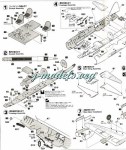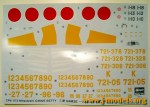

Hasegawa ha echado el resto con esta maqueta. El modelista que desee «bailar» con esta gorda Betty va a tener que armarse de paciencia para afrontar las más de cien piezas que tiene, sin contar el cohete Ohka, en nada menos que 15 bandejas más las calcas. El despiece del aparato es prácticamente igual que si fuese un modelo a una escala mayor, con multitud de detalles que requieren un trabajo por fases preciso para que el conjunto no desmerezca.
El único punto negro que le veo a este modelo es que sólo está concebido para mostrar ambas aeronaves por separado, pues el Ohka no puede montarse bajo el fuselaje del bombardero sin hacer importantes modificaciones, y aunque decidamos hacerlas, no se verán los detalles de la cabina del cohete. Aparte de esto, el modelo se presta a multitud de elogios. Para empezar, la carlinga y todo el interior, que es una profusión de detalles: radios, bombonas de oxígeno, ametralladoras, etc. Luego, las alas y el tren de aterrizaje, que parecen de un modelo a 1/48 y además las ruedas ya vienen cortadas para simular el peso del avión. Si consideramos los transparentes, hay para hartarse, desde las ventanas laterales (grandes y pequeñas) a la torreta giratoria, el morro, la cola, y aún nos sobrará alguna pieza. De los motores, ya ni escribo.
La bomba Ohka está al mismo nivel del avión, pero aún más reducida. Da pena ponerla bajo éste por lo bien reproducida que está con su calca para el panel de mandos y todo, pero Hasegawa ya ha pensado en eso y nos tiene preparado un carrito de transporte.
Las calcas, excelentes, vienen en una gran hoja con multitud de numerales para escoger. Las instrucciones, al nivel que nos tiene acostumbrados la marca japonesa, presentan cuatro esquemas de pintura del bombardero: dos de ellas totalmente en verde oscuro Mitsubishi, otra con el esquema típico de la Marina verde oscuro y gris, y por último otra más con la combinación verde oscuro sobre negro. Todas estas versiones pertenecieron a diferentes escuadrones de ataque basados en Japón entre marzo y abril de 1945. El cohete Ohka iba completamente de gris.
Esta maqueta, de alta calidad general, bien merece que se le dedique tiempo y esfuerzo, pues tiene todos los requisitos para ser un modelo soberbio una vez terminado.◊

Hasegawa has gone all out with this kit. The modeler wishing to «dance» with this fat Betty has to be patient to face more than 100 parts, not counting the Ohka rocket, in no less than 15 sprues and the decal sheet. Such number of parts and details is similar to a good model in a bigger scale and will need an accurate step-by-step work for the overall final look not to lose value.
The only drawback I see in this model is that it is thought to display both aircrafts separately, because the Ohka cannot be assembled under the fuselage without major modifications, and if we decide to make them, important details in the rocket cockpit will not be seen. Apart from this, the kit should not be but praised. To start with, the cockpit and the interior, where everything is a detail: radios, oxygen cylinders, machine-guns, etc. Then, the wings and the landing gear, that seem bound to a 1/48 model and the wheels are already cut to simulate the «weight» of the plane too. If we have a look at the clear parts, you have so many of them as to be fed up, from windows (large and small) to the turret, the nose, the tail gun position and so on (you even have some spare parts here) and the same is true about the engines.
The Ohka bomb is on the same level but in a smaller size. It is a shame to place it under the plane because its fine cockpit details will be lost, but Hasegawa has already thought about that and they have prepared a handy dolly.
The decals, excellent, come in a large sheet with lots of code numbers to choose. The instructions, Hasegawa’s own, show four colour schemes for the bomber: two overall Mitsubishi green, another one in the typical IJN green over grey, and finally a combination of green over black. All these versions belonged to different attack squadrons based on Japan between March and April 1945. The Ohka was simply painted in overall grey.
This kit, a high-level model in all senses, is worth time and effort to get the best out of it because it has all to be a really superb model once finished.◊
Actualizado – Updated: 5 / 2022
Actualizado – Updated: 5 / 2017
Publicado – Published: 9 / 2006
©www.jmodels.net







Debe estar conectado para enviar un comentario.